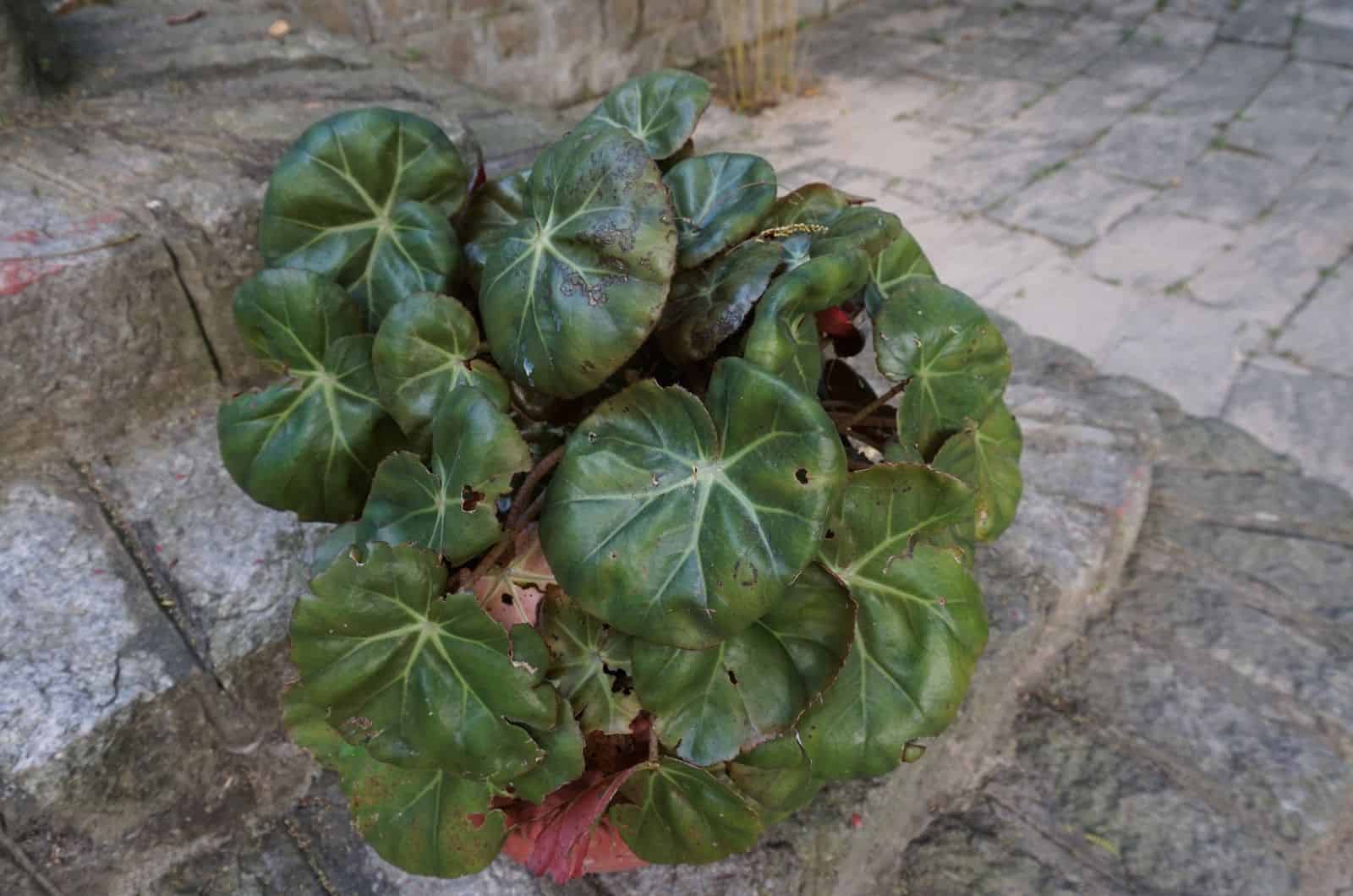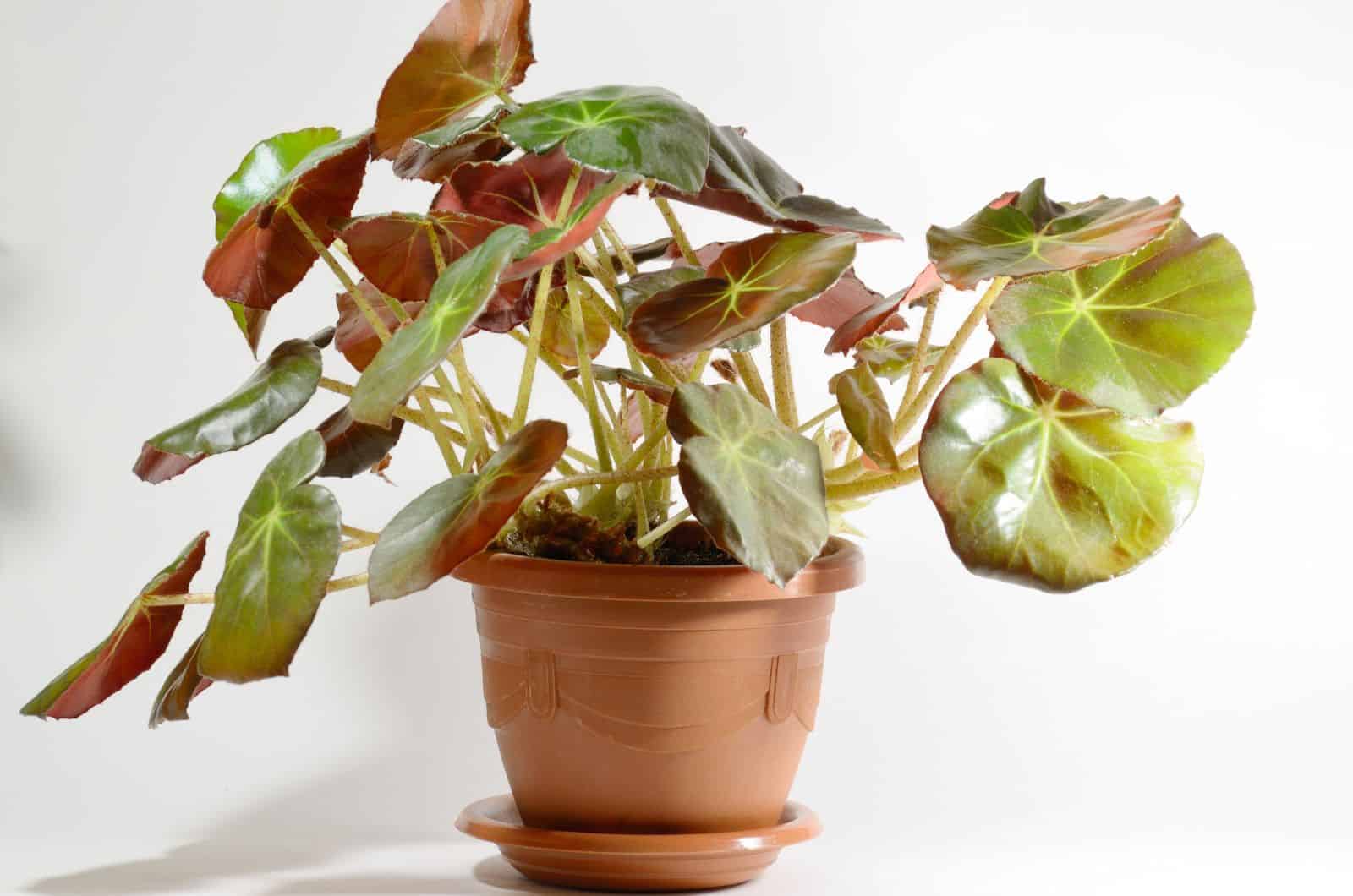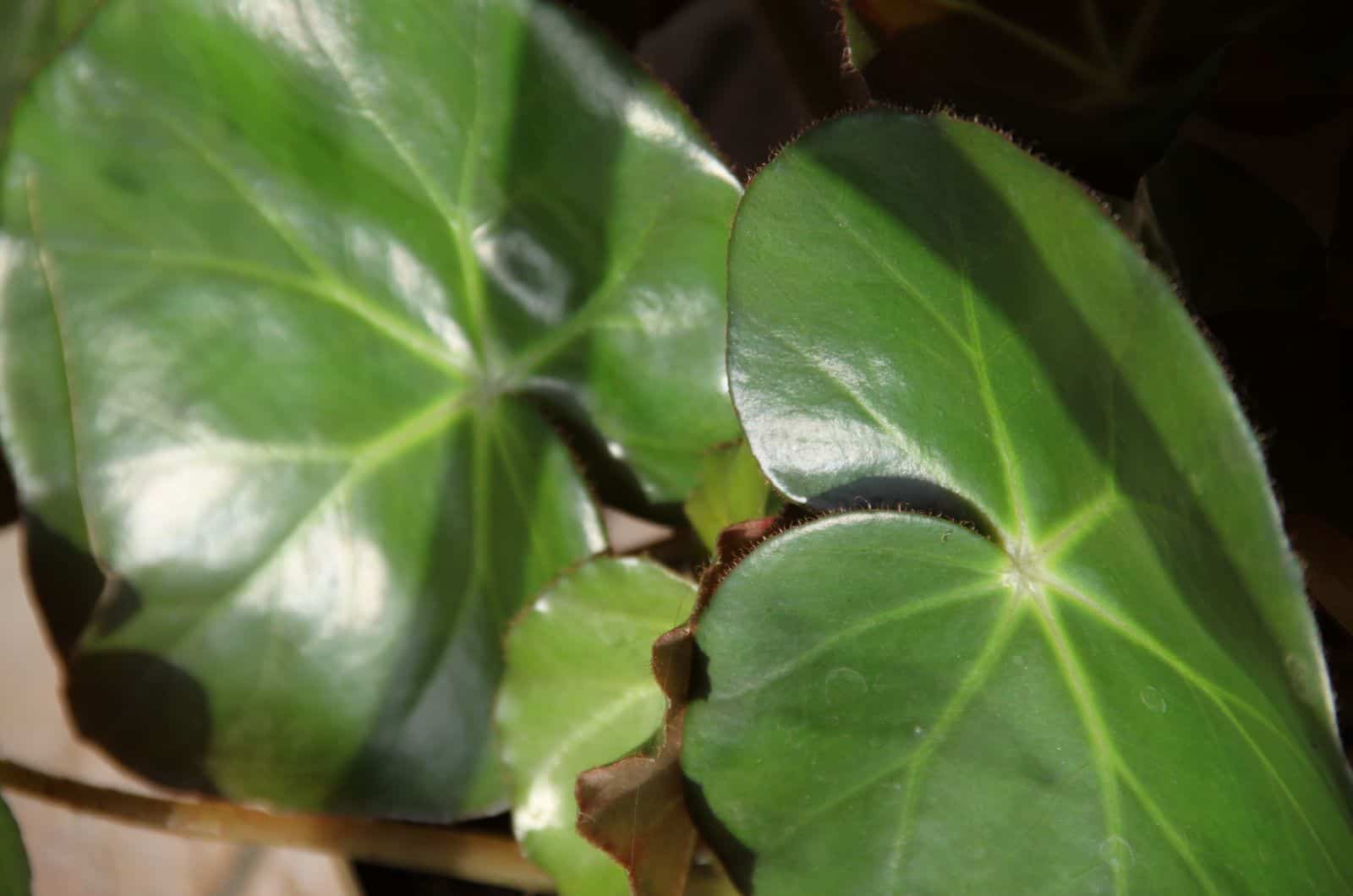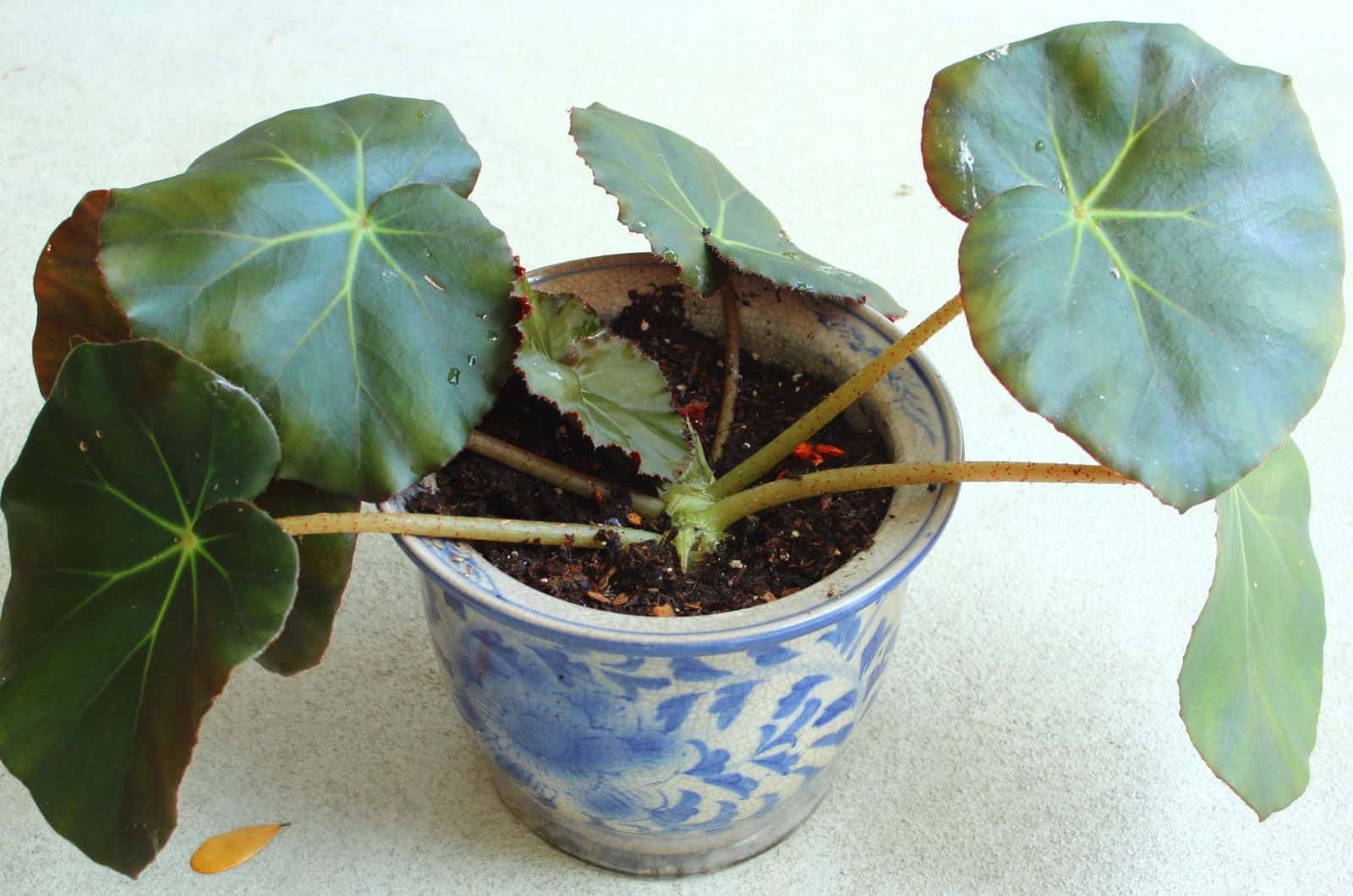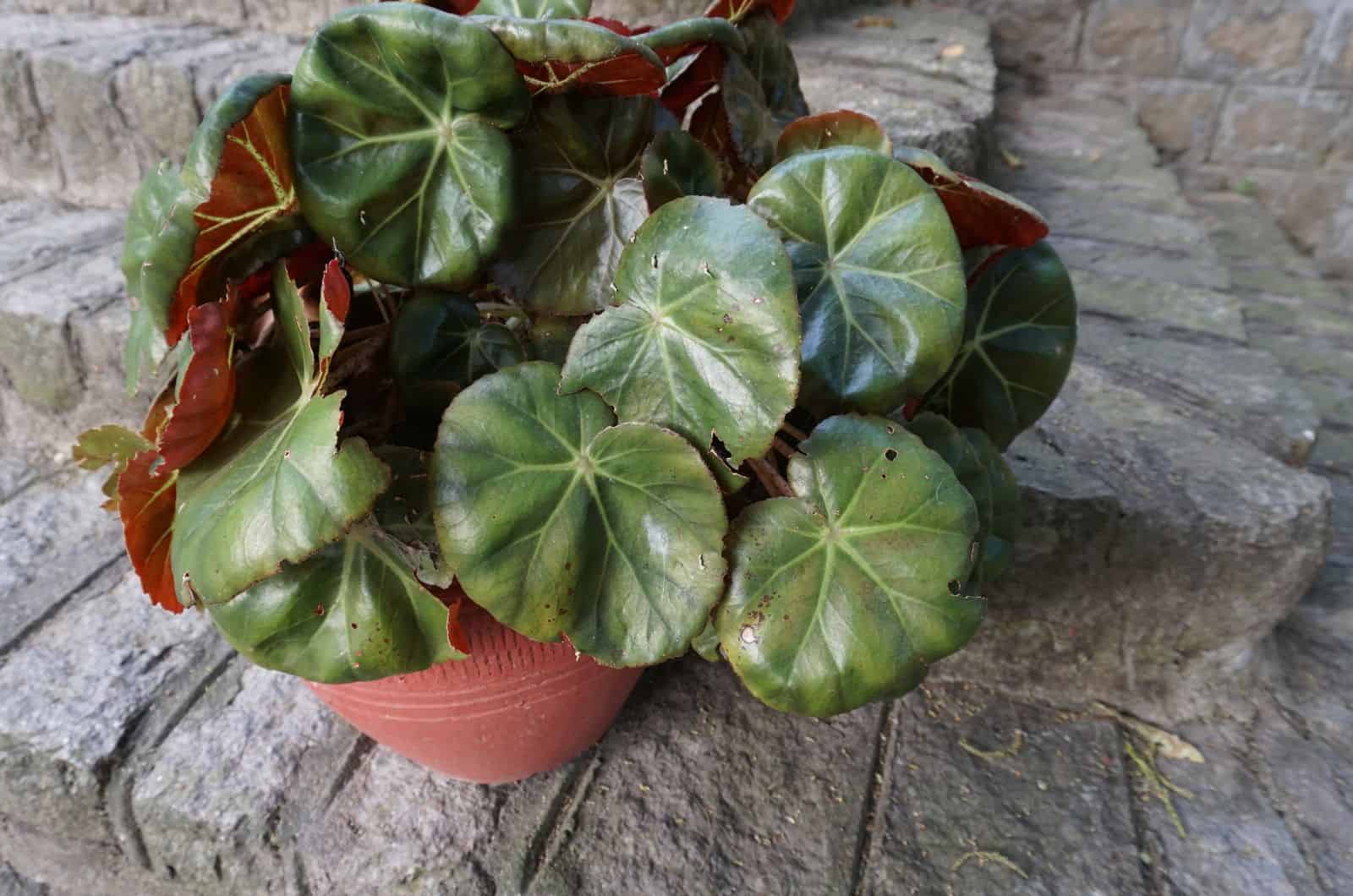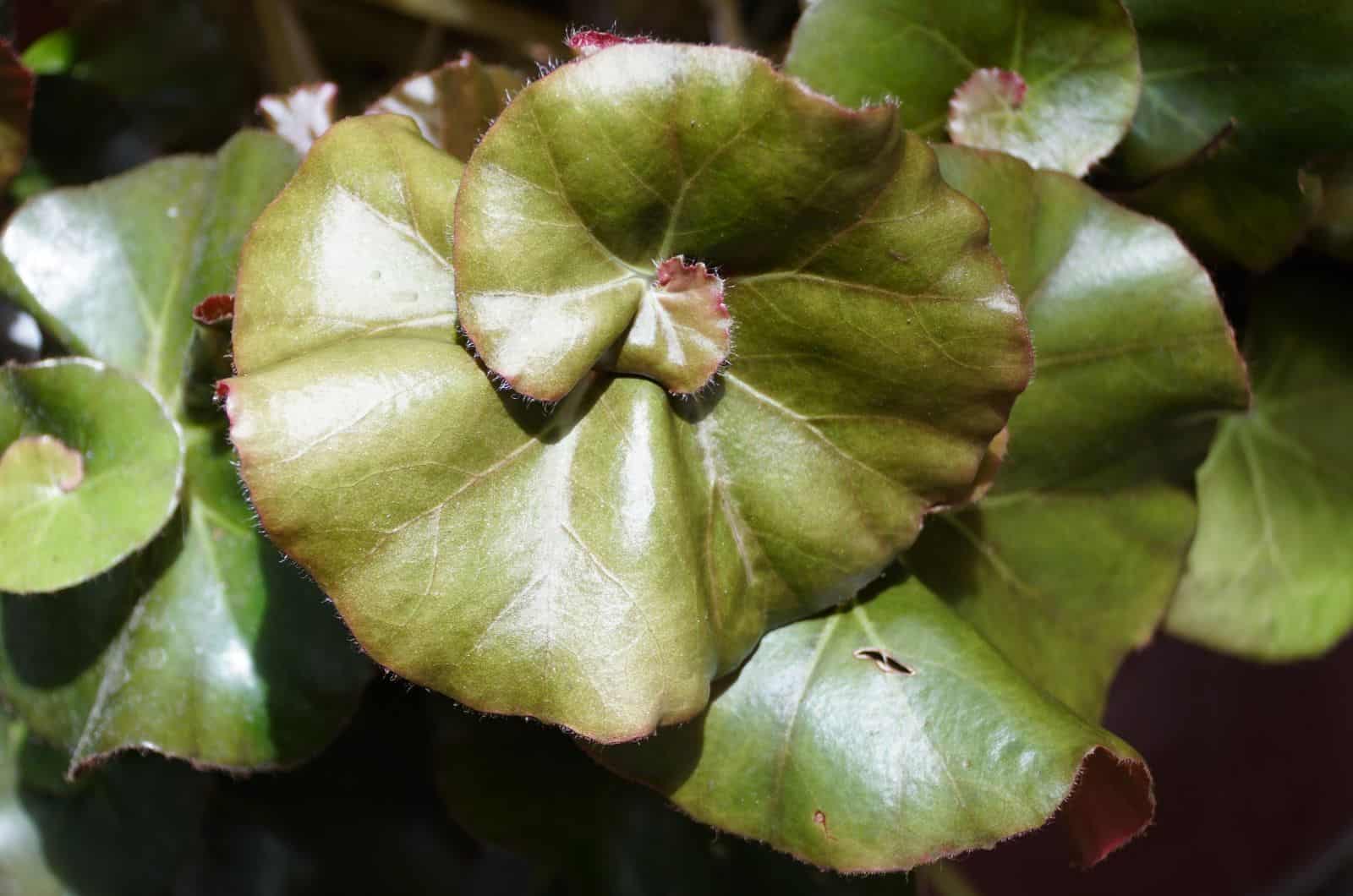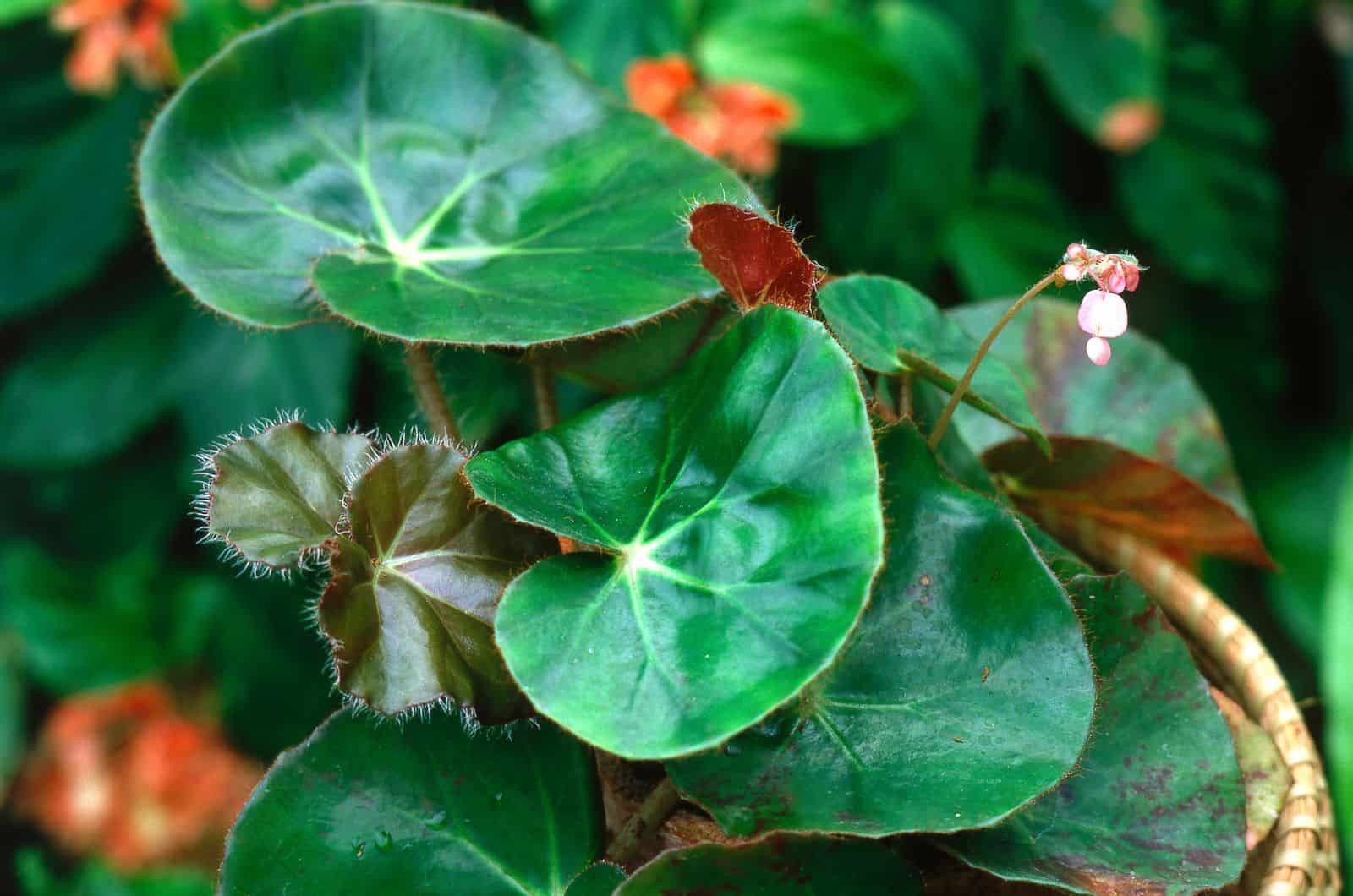Today, I want to present to you a forgotten plant that was once a part of every household. Nowadays, it’s uncommon to see someone growing this plant. Meet the Begonia beefsteak, the plant with a pretty weird name but a unique, fascinating appearance.
A long time ago, specifically in 1845, a German horticulturist decided to make a hybrid of two Begonias, the manicata and hydrocotylifolia, both tropical plants.
The beefsteak adapted well to pretty harsh temperature conditions and became a desired houseplant.
Now, I would like to show you what makes this Begonia unique and why you should grow one.
Before we move on, let’s see some basic info.
| Family | Begoniaceae |
| Genus | Begonia |
| Scientific name: | Begonia erythrophylla |
| Common names: | Begonia beefsteak, beefsteak begonia |
| Native habitat: | Germany |
| Type | Evergreen perennial rhizomatous plant |
| USDA hardiness zones: | 10–11 |
Let’s start!
What Does The Begonia Beefsteak Look Like?
The unique circular leaves and pink flowers, which would make any plant collection even more beautiful, make the Begonia beefsteak stand out.
Let’s see a detailed description of the beefsteak plant’s appearance.
Leaves
What makes this Begonia special are its flowers, but, in my opinion, the leaves are just as beautiful. They have a somewhat round shape, and at the juvenile stages, the leaves are brownish-red, and as the beefsteak plant matures, the leaves become darker.
The shape of the leaves is similar to the Pilea peperomioide’s, but the leaf color and flowers make the Begonia beefsteak different.
When you are looking at the leaves, it may seem like you’re looking in a mirror. But, such leaves are really delicate, especially to direct sun. Don’t worry; I’ll show you where to place this Begonia and how to avoid any light issues.
Flowers
I know that some gardeners aren’t really into leaves but choose plants due to the flowers’ shapes and colors.
But, the beefsteak begonia also has remarkable flowers. Pink, vibrant leaves give the impression of a crown if you look at the plant from a distance.
This Begonia blooms in spring or at the beginning of the winter. You’ll notice the flowers have stems that seem to hang on the beefsteak begonia’s top.
You’ll also notice two to four petals that form a bell shape once they reach their full size. Read on to find out how to keep Begonias blooming.
Fragrance
Before I started growing my Begonia beefsteak, a friend of mine told me that it doesn’t have a special fragrance.
So, I didn’t expect to scent anything; however, I noticed the plant had a mild scent at its juvenile stages. When the blooming time came, the fragrance became strong, and now, each time my Begonia beefsteak is in full bloom, I come closer to it to enjoy the beautiful scent.
The great thing is that you can make the scent even stronger if you ensure a higher soil pH.
Growth Rate
Beefsteak is considered a fast grower when provided with the right conditions. You’ll notice active growth during spring and summer (its growing season).
So, it’s essential to ensure adequate light, proper humidity, enough water, and food during that period.
If you notice slow growth or any other issues during this period, you’ll need to check if the plant has everything that it needs.
However, don’t expect it to grow during the winter months as the beefsteak plant goes into dormancy.
This Begonia can grow up to 18 inches tall and 26 inches wide. Experienced gardeners will tell you to stake this Begonia to support its heavier stems and encourage growth.
Suggested uses
Many growers have plant collections and grow plants due to their ornamental features.
But, this Begonia isn’t only beautiful, it also has health benefits. You can consume the flowers (yes, you read it right).
The most common use of this Begonia is for tea. If you have a cold and drink this tea, it can help you to recover.
Additionally, it has been used for asthma and the digestive system. It has been commonly used in the cosmetic industry too, as it helps with skin.
This Begonia also has one more benefit when grown as an indoor plant; it’s an air-purifier, so placing it in your bedroom is a great idea.
How To Care For The Beefsteak Begonia
This Begonia is considered to be a low-maintenance plant. Now you must’ve been asking yourself why it’s considered easy to care for. At first, it may not seem very easy to care for as its list of necessary conditions is pretty long.
But once you get the gist, it becomes a piece of cake.
Before we move on, here’s a table so you can gain a general insight into its plant care.
| Light | Bright indirect lightHumidity: Moderate to high humidity |
| Temperature | 45–85 ℉ |
| Soil | Well-draining, fertile, porous, with a pH of 6.1–7.5 |
| Watering | Summer—once a week, winter—two to three times a month |
| Fertilization | Once or twice a month during the growing season |
| Pruning | Not obligatory; only dead or diseased leaves |
| Repotting | Every 1–2 years |
Let’s look at a complete guide to beefsteak Begonia care!
Light
Before you start growing beefsteak begonia, you need to know that it needs a lot of bright light. This may seem harder to achieve when you grow it indoors, but there are always tips and tricks that can aid in this.
This Begonia tolerates low light, but why take a chance when you can give them ample light instead?
The best option is to ensure that it receives 8 hours of bright indirect light daily. The plant will also benefit from the morning sun, so try to ensure that.
But, be extremely careful with direct sunlight. Its leaves could get burned by excessive sun, which also discolors the leaves and browns the edges.
In cases of too little light, the leaves will most likely droop and wilt.
Additionally, inadequate lighting slows down photosynthesis, which stresses the plant.
As you may know, the amount of natural light available is lower during winter. Consider getting grow lights to ensure enough light.
You can use grow lights during other seasons if you’re not sure if your Begonia beefsteak is receiving enough light.
How To Ensure Enough Light
I would like to give you a couple of tips concerning light. The first thing that you can do is to rotate your beefsteak begonia weekly, so that each side gets the proper amount of light.
Also, be careful that the light levels don’t change too quickly. For example, if you ensure bright light, don’t expose your plant to low light by moving it elsewhere. This plant doesn’t respond well to sudden changes.
I recommend placing your Begonia near an east-facing window for the best results. Alternatively, use north- and south-facing windows, but be more careful with the exposure.
For example, you can create partial shade for your beefsteak begonia by placing sheer curtains on the windows to protect the plant from the direct sun.
Humidity
Luckily, this Begonia grows well in a range of humidity levels. However, moderate humidity (50%) will give you the best results.
Most households have slightly lower humidity, and this Begonia will grow well in such conditions.
But, I always recommend staying on the safe side and not risking anything that may upset your plant’s ideal conditions.
The best way to control and increase humidity, if necessary, is to use a humidifier. Another excellent method is to use a humidity tray. This isn’t an expensive item, and you can go with a DIY version by placing pebbles in a tray that you’ll put underneath the pot.
Pour in some water, and don’t let the beefsteak’s roots come into contact with the water.
The most common method that gardeners use when it comes to humidity is to create a microclimate. This may sound like something that’s hard to do, but it just means that you group all of your plants together.
However, be careful with this method. If you suspect that a plant is facing pests or diseases, make sure to isolate it as it could otherwise transmit pests or diseases to your other plants.
Placing your beefsteak Begonia in bathrooms or kitchens is another excellent idea. Finally, mist the leaves regularly. Use distilled water and make sure that any water drops don’t stay on the leaves as they could cause rotting.
Temperature
When it comes to the temperature, anything between 45 and 85 degrees Fahrenheit will work well.
45 degrees Fahrenheit is the lowest temperature that you should go with, as lower temperatures may disrupt the cellular activities that are needed for growth.
First, as we mentioned, low temperatures may stunt the growth as they slow down cellular activities, and second, they may stress the plant and it will droop.
On the other hand, anything above 85 degrees Fahrenheit will also affect the health and appearance of your Begonia beefsteak.
As you may know, excessive temperatures increase the transpiration rate, resulting in the plant losing too much water.
USDA zones 10 and 11 are perfect for growing beefsteak plants outdoors and you’ll only need to take care of the sun exposure and chilly winter nights.
Heating sources are enemies of the beefsteak plant, meaning that spots near radiators and fireplaces aren’t the best options for housing your plant.
The question is, what can you do to maintain the right temperatures? First, increase the humidity using the tips that I’ve given you. Excessive temperatures will increase the transpiration rate, but high humidity will help the plant’s soil to have enough moisture in it.
If you grow this Begonia indoors, place it away from windows during winter to avoid temperature fluctuations. If you grow it outdoors, put some mulch on the soil to protect it from freezing.
Soil
We all know that without adequate soil, our plants will grow poorly or won’t grow at all. So, what kind of soil does this Begonia need to grow well? First, and most importantly, you’ll need to ensure well-draining soil unless you want to suffocate the roots in waterlogged soil.
Second, the soil must be porous and light to help the roots breathe. If the soil is too compact, it will have fewer air spaces and the airflow will be disrupted, so the beefsteak’s roots won’t be able to breathe.
And third, the soil needs to have the correct pH. 6.1 to 7.5 is the best pH range for the beefsteak plant. You can add a little orchid bark to increase the pH.
So, we need a soil type that meets all of the above requirements. You can purchase a ready potting mix and if you are doing so, buy the one made for African violets.
However, you can make an adequate potting mix yourself. You’ll need regular potting soil and materials that will ensure better drainage and promote airflow.
Use one part potting soil, one part perlite (or pumice), and one part coarse sand+fertilizer (well-rotten manure or worm castings), and you’ll make the perfect soil for this Begonia plant.
Watering
There are two things to avoid when it comes to watering. First, you’ll need to pay attention to ensure that the soil isn’t waterlogged; second, the soil shouldn’t be entirely dry.
Even if the right conditions are ensured, the watering schedule will change depending on seasons and the beefsteak plant’s growth stage.
For example, you’ll need to water the plant more frequently during spring and summer and reduce watering during dormancy.
Remember that the Begonia beefsteak loves moist soil, but overly wet soil will attract fungi that will cause root rot. Additionally, excess water will cause the soil to become compact, disrupting the airflow.
Therefore, if fungi don’t inhabit the soil, the plant will still face issues such as root suffocation.
The Begonia beefsteak resembles succulents due to some of its features. Succulents use the leaves to store water and, in that way, help the plant to survive drought.
This Begonia doesn’t store water in its leaves but rather in rhizomes. If the soil is too wet, the leaves will turn yellow, the roots will rot, and the plant will droop.
But the problems don’t stop there. So, don’t let the soil dry entirely and avoid underwatering. The leaves will scorch, curl, and become crispy if the plant lacks water.
How And When To Water The Beefsteak Begonia Plant
You’ll need to create an adequate watering schedule and be consistent. The general rule is to water this Begonia twice a week at the beginning of the growing season and once or twice a month during dormancy.
But, all gardeners know that relying too much on a watering schedule isn’t the right thing to do. I always recommend checking the soil moisture each time, before you water the plant.
To measure the moisture level, use a finger or wooden stick, or go with the safest option, a moisture meter. If the topsoil is 2–3 inches dry, it’s time to water your Begonia.
When watering, use room temperature water, filtered water, and water your plant thoroughly until the water starts coming out of the drainage holes. Your Begonia won’t benefit from light watering.
Fertilizing
This hybrid Begonia isn’t a heavy feeder, but you’ll need to fertilize it to avoid any nutritional deficiencies.
Two factors play significant roles in feeding, the frequency and the type of fertilizer. Feed your beefsteak plant once or twice a month during the growing season using an all-purpose liquid houseplant fertilizer.
Please dilute this fertilizer to half strength before using it, as this Begonia is delicate and may suffer from fertilizer burns.
Organic fertilizers, like well-rotten manure, are also a great choice for feeding this Begonia hybrid.
Pruning & Cleaning
When growing plants, pruning is an essential part of their care. Still, for the Begonia beefsteak, pruning won’t affect the growth in terms of promoting it.
The only time that you must prune is when you notice discolored or diseased leaves. Use sharp and sanitized tools and always cut at the base of the leaves.
The cleaning part doesn’t refer to washing the leaves or any other special action but instead, removing dust from the leaves.
Wipe off the dust with a soft sponge that’s been dipped in only clean water. You don’t need any commercial products for this purpose; honestly, it’s a waste of money.
Repotting
Although the Begonia beefsteak won’t show any sign of distress when rootbound, you shouldn’t leave it in that condition for too long. Therefore, you’ll need to repot it.
First, let’s discuss the new pot. It should be slightly larger, as a smaller pot will not provide enough space for root growth.
On the other hand, the pot shouldn’t be too large. If there is too much soil around a beefsteak’s roots, the excess water will sit there and cause the roots to rot.
Choose an 8-inch pot made of terracotta and search for one that has drainage holes.
You can repot your Begonia every two years for the best results.
Let’s see how to repot it.
How To Repot A Begonia Beefsteak
I’ve discussed the pot, and besides this, you’ll need fresh soil for new nutrients.
Here are the steps for repotting a beefsteak Begonia.
1. Remove one-quarter of the soil from the pot and take the plant out. You can hold it from the stem base but make sure not to pull it too hard.
2. Loosen the soil around the roots until you expose the root system.
3. Fill half the new pot with fresh soil and make a shallow hole in the center.
4. Place your beefsteak plant in the hole and add the remaining soil.
5. Water your Begonia and put it in indirect light.
Begonia Erythrophylla: Propagation
The great thing about this Begonia is that you can easily propagate it. If you have propagated Begonia maculata before, you won’t have any problems when propagating the beefsteak variety.
There are four ways to propagate the beefsteak plant; stem cuttings, leaf cuttings, rootball division, and rhizome division.
Let’s see each!
Stem Cuttings
Many think that rhizome division is the easiest way to propagate rhizomatous plants. SHowever, the easiest way is actually to propagate it by stem cuttings.
Here are the steps for this method of propagation.
• Sanitize the cutting stools.
• To take the stem cuttings, select a healthy stem and cut a section that is about 6–8 inches long.
• Now, you should decide where to root the cuttings. You can use soil or water propagation. When rooting in water, you can place the cutting in a jar of water until new roots sprout and then place them in soil.
• When putting the cuttings in the soil, make a hole so that the new roots have enough space to grow. If you didn’t root in water, make sure the bottom part of the cutting in the soil is deep enough.
• Place the pot in bright indirect light and mist it regularly.
Rootball Division
Another way to propagate the beefsteak plant is to divide the rootball.
Here are the steps!
• Remove the Begonia beefsteak from the pot and loosen the soil.
• Find the healthy offsets and divide them from the mother plant. If you have issues dividing it using your hands, feel free to use sanitized cutting tools. The offsets should have a few leaves and roots.
• Dip the cut part in rooting hormone or turmeric powder (this step is optional).
• Place the section in water or directly in soil.
Rhizome Division
The third way to make more beefsteak Begonias is to divide the rhizomes.
Follow these steps.
• Remove the Begonia beefsteak from the pot and loosen the soil.
• Select mature and long rhizomes and cut them.
• Now, divide the rhizomes; the number of sections isn’t limited as long as each section is 2–3 inches long.
• Place the sections in the soil and place the container in bright indirect light.
Common Problems
Begonia erythrophylla is affected by common diseases and pests. When it comes to diseases, most of them are caused by watering issues.
If your plant is inhibited by pests or suffering from a disease, please isolate it until you have fixed the problem.
Pests
The pests that may visit your Begonia beefsteak are aphids, spider mites, scales, and whiteflies.
If aphids inhibit your Begonia, you’ll notice deformed and curling leaves that are covered by a sticky substance. Always check the undersides of the leaves as they like to hide there.
Spider mites will leave webbings and will usually cause discoloration of the leaves.
Scales cause tiny brown bumps on the leaves, making them wilt and appear discolored.
If you notice small bugs flying around your Begonia and the leaves have blotches and have turned yellow, you might be dealing with whiteflies.
You can remove all pests with rubbing alcohol, a dishwash and water mix, or neem oil.
Diseases
If you notice black or brown spots on the leaves, your Begonia beefsteak may be suffering from leaf spot disease. Remove any diseased leaves and apply fungicide or neem oil to the healthy leaves.
Black or brown spots, rotting of the leaves, and yellow flowers may be indicators of botrytis blight. You’ll need to remove such leaves with sanitized shears.
Powdery mildew is another disease that may affect your beefsteak plant. If your plant suffers from this disease, the leaves will display yellowing and have a white coating on their surface. You can cure a mild infection with a sulfur-based fungicide.
A widespread disease that affects houseplants and beefsteak begonia isn’t an exception; it is root rot. It’s caused by overwatering as soggy soil attracts the pathogens that are responsible for this disease. You’ll need to repot your beefsteak plant. Remove the diseased roots and spray the root system with a fungicide.
You’ll notice yellow leaves, mushy soil, and a foul odor if your beefsteak plant is suffering from root rot.
FAQs
Is a beefsteak begonia toxic?
A Beefsteak Begonia is safe for humans but toxic to pets. If your pet ingests the plant, please seek professional help as dissolved calcium oxalates may cause many issues.
Are beefsteak begonias rare?
Beefsteak Begonias are rare plants, and the vast majority are heirloom plants. The main reason for this is that the plant isn’t as popular nowadays as it was a long time ago. It has been replaced with other Begonia varieties.
Do beefsteak begonias bloom?
The Beefsteak Begonia belongs to the genus Begonia, and all of the plants from this genus bloom. When the plant matures, it produces fascinating, circular, olive-green leaves and pink flowers.
Wrapping Up
I’m always asking myself why the Begonia beefsteak stopped being popular. It’s easy to care for, easily propagated, and so unique that every household with one looks terrific.
I’m sure that after reading this article, you’ll get one and I can assure you that it will reward you with its fascinating flowers if you take good care of it.
Now that you know all about this plant, why don’t you go and look for a cutting for yourself! It’s worth it!
Until next time!
Like this post? Share or pin it for later!

